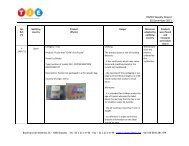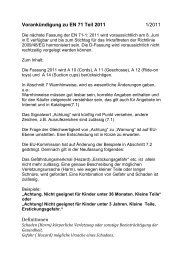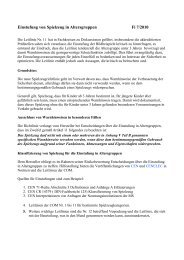Create successful ePaper yourself
Turn your PDF publications into a flip-book with our unique Google optimized e-Paper software.
<strong>EN</strong> <strong>71</strong>-1:<strong>2005+</strong><strong>A8</strong>:2009 (E)<br />
8.35.2.2 Calliper square or similar device capable of determining dimensions to an accuracy of 0,1 mm.<br />
8.35.3 Procedure<br />
8.35.3.1 Measurement of flux density<br />
Place the tip of the Gauss meter’s probe in contact with the pole surface of the magnet. For a magnetic<br />
component (where the magnet is fully or partially imbedded in part of the toy), place the tip of the probe in<br />
contact with the surface of the component.<br />
Maintain the probe in a position perpendicular to the surface.<br />
Move the probe across the surface to locate the maximum flux density.<br />
Record the maximum flux density.<br />
8.35.3.2 Measurement and calculation of the pole surface area<br />
If the magnet is imbedded/attached as part of a magnetic component, extract the magnet from the component<br />
even if it is necessary to break the toy.<br />
If the pole is not flat (for example, hemispherical), measure the maximum diameter of the magnet<br />
perpendicular to an axis through the magnet poles (see Figure 33), with an accuracy of ± 0,1 mm and<br />
calculate the area of the corresponding cross-section.<br />
If the pole surface of the magnet is flat, measure the dimensions with an accuracy of ± 0,1 mm and calculate<br />
the area using the appropriate geometric formula.<br />
For multi-pole magnets measure and calculate the area of the largest single pole, which can be identified<br />
using magnetic field viewing film or equivalent.<br />
NOTE An example of multi-pole magnet is a rubberized/plastoferrite magnet, consisting of multiple strips of<br />
poles.<br />
8.35.4 Calculation of magnetic flux index<br />
The flux index (kG 2 mm 2 ) is calculated by multiplying the calculated area of the pole surface (mm 2 ) of the<br />
magnet by the square of the maximum flux density (kG 2 ).<br />
Key<br />
1 Maximum cross-section perpendicular to the axis<br />
2 Axis through the magnet poles<br />
Figure 33 – Maximum diameter of magnet with a non-flat pole0<br />
75








